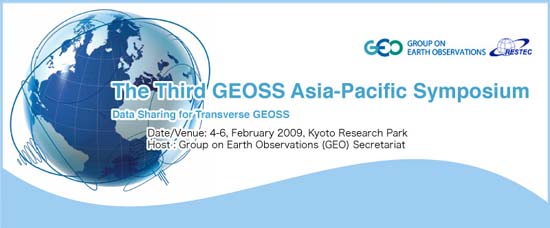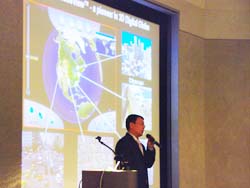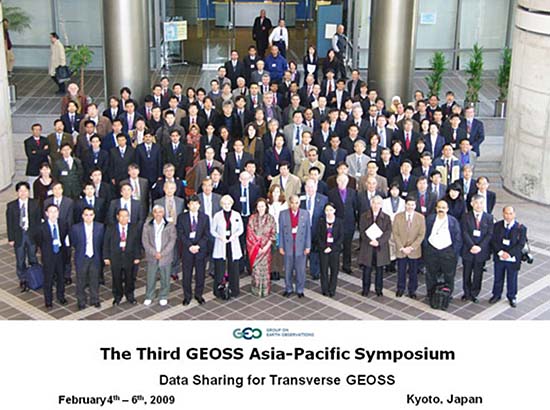The Third GEOSS Asia-Pacific Symposium
Data Sharing for Transverse GEOSS
-Comments form Organizer & Parallel Sessions' Co-chairs-

From February 4 to 6, 2009, the Third GEOSS Asia-Pacific Symposium “Data Sharing for Transverse GEOSS” (3rd GEOSS AP Symposium) was held at the Kyoto Research Park in Japan. The symposium was organized by the secretariat of the Group on Earth Observations (GEO) with the support of the Japanese government. Over 250 participants from 33 countries attended the symposium.
Comments form the Chair of Each Parallel Session
Parallel Session WG1: Monitoring and Predicting Climate Change
Co-chaired by Dr. Yukihiro Nojiri and Dr. Nobuko Saigusa, National Institute for Environmental Studies (NIES), Japan
The objectives of this parallel session are:
- To discuss issues in the observation of CO2 and other greenhouse gases (GHG) in response to the needs of Earth system modeling for the Asia-Pacific region; and
- To clarify the future outlook for improving climate change projections using Earth system models.
In this session, there are four presentations regarding top-down and bottom-up approaches to quantify the global mass balance and fluxes of GHGs as well as a regional impact assessment based on the climate change projection by climate model. There are observational gaps for atmospheric CO2 and methane observation in the regions of South America, Siberia, Africa and South and South-East Asia. We expect the data from GOSAT and OCO to fill these gaps. On the other hand, there are still substantial gaps in the spatial scales of estimations of surface fluxes between bottom-up approaches by tower flux measurement, and top-down approaches by inverse technique and O2/N2 ratio. Based on the discussions in this session, to be able to estimate terrestrial and oceanic CO2 sink/source it is important to enhance collaboration and information exchange between different observation areas. We already have data exchange systems such as WDCGG, CDIAC, FLUXNET, and IOCCP. However, we need to enhance the data integration activities in the Asia and Pacific regions through these data exchange systems. We expect to enhance such activities through the GEOSS framework.
Parallel Session WG3: Monitoring changes in ecosystems, biodiversity and ecosystem services
Chaired by Dr. Tetsukazu Yahara, Kyushu University
Ecosystems and biodiversity provide us with a series of resources including clean water, fresh air, food, fuel, fibres, medicines, and amenities. With the increasing effects of human activities, however, all of these resources are degrading. Thus, there is an increasing demand to monitor changes in ecosystems and biodiversity in order to maintain the ecosystem services derived from them.
In this session, the current progress in developing observations of changes in ecosystems and biodiversity was reported from six monitoring activities: Japanese Long-Term Research network (JaLTER); An Integrative Research on Ecosystem Services Management in Asia (ECOSMAG) of Global Land Project (GLP) and Asia-Pacific Network for Global Change Research (APN); vegetation monitoring using satellites in the Japan Agency for Marine-Earth Science and Technology (JAMSTEC); Global Biodiversity Information Facility (GBIF); East and Southeast Asia Biodiversity Inventory Initiative (ESABII) promoted by the Biodiversity Center of Japan, the Ministry of the Environment; and GEO Biodiversity Observation Network (GEO BON). Based on these six reports, we discussed how to promote progress in standardizing data management systems, networking satellite and ground projects, identifying users and user needs, providing products useful for conserving and ensuring sustainable use of biodiversity, and developing communication and collaboration among researchers in various research fields. We agreed that there is an urgent need to develop some headquarters under GEO to coordinate various monitoring activities in the Asia-Pacific region. Based on this agreement, we decided to have a symposium to organize a Japanese committee for promoting GEO BON (JBON) this coming May. Until the third GEOSS-Asia Pacific symposium, we will have some additional symposia and workshops to develop Asian activities under GEO BON. The third GEOSS-Asia Pacific symposium is going to be held in 2010, which has been declared the International Year of Biodiversity, as well as the year of the 2010 Biodiversity Target (to achieve a significant reduction of the current rate of biodiversity loss by 2010) reviewed in CBD COP10. The next symposium is expected to provide a timely opportunity for assessing changes in ecosystems and biodiversity in the Asia-Pacific region and reviewing how the 2010 Biodiversity Target can be achieved.
Parallel Session WG6: The Interdisciplinary Collaboration of “Ecosystem - Climate Change - Disaster”
Co-Chaired by Dr. Yoshiki Yamagata (NIES)
In this working group, there were the following presentations on promotion of integrated projects, especially on promotion of cooperative relationships among every field which include ecosystems, climate change and disasters, and we eagerly discussed those promotions.
”Linkage with JaLTER and Monitoring 1000 (Prof. H. Shibata, Hokkaido University)
Ongoing programs, data sharing and international cooperation on ecosystems and biodiversity on the basis of JaLTER and Monitoring 1000 were introduced.
“Linkage with AsiaFlux” (Dr. N. Saigusa, NIES)
Comparison of sites using AsiaFlux and LTER data and comprehensive observations at core sites are being implemented.
A feedback network on long-term reactions of ecosystems is needed.
”Forest remote sensing with ALOS (Dr. M. Shimada, JAXA)
As activity of the K&C initiative, forest and global environment monitoring by PALSAR and systematic observation has been promoted.
Monitoring maps will continue to be produced toward future forest monitoring activities.
”Forest remote sensing in Thailand (Dr. Chaowalit Silapathong, GISTDA)
As research on applications to the forest sector using remote sensing in Thailand, classification of forest types, production of forest maps, monitoring of deforestation, management of afforestation, detection of forest fires, land cover change of forests and tracking of carbon, and application of SAR to the forest sector were introduced.
”Linkage to regional Sentinel-Asia Initiative (Dr. Alex Held, CSIRO)
'Task on forest mapping and carbon tracking 2009-2011' was introduced as a new task of GEO.
Information on forest cover is available as an indicator of the possibilities of future risks and of reductions in ecosystem services. And also an integrated system, CSIRO, will promote the compatibility of modeling frameworks and the sharing of data.
“Ecosystem modeling for global forest carbon monitoring” (Dr. Akihiko Ito, NIES)
Modeling is a useful tool because it finds valuable data among data obtained by different observation programs, and enables such data to be used in an integrated way.
Close cooperation between observation and modeling is needed in order to reduce uncertainties and allow reliable forecasts to be made.
”Forest carbon monitoring studies in Southeast Asia (Dr. Denis Dye, USGS)
'US-Japan-Southeast Asia workshop on carbon activities and the sustainability of tropical forests in monsoon Asia', held in Thailand in January 2009, was introduced.
Linking carbon budget models and remote sensing of forest change (Dr. Gary Richards and Dr. Rob Waterworth, Dept. of Climate Change)
An IPCC guideline has defined the estimation method, and the contracted countries have agreed to a common format type and we have to obey it.
A connection between ecosystem modeling using remote sensing and time series wall-to-wall is one approach.
“Application to ecosystem vulnerability assessment” (Dr. Daniel Murdyaso, CIFOR)
An assessment method of ecosystem vulnerability and the connection between application and mitigation were introduced.
Criteria and indicators for ecosystems' vulnerability to climate changes are needed.
REDD could be the first step to reduce the vulnerability of ecosystems.

Opening
Prof. Jose Achache
GEO Secretariat Director
Keynote Speech
Dr. Vincent Tao, Microsoft

3rd GEOSS AP Website: http://www.prime-intl.co.jp/geoss/
GEO Website: http://www.earthobservations.org/